Auto-login: As good as PC-BSD’s installer is, it has several shortcomings. One of which is the auto-login feature, enabled by default. While it can be very convenient, enabling auto-login is not good for the physical security posture and rating of your computer. It is so bad that some of the Linux distributions, like Fedora and Mandriva, have effectively removed it as an option in their graphical user management application. Auto-login is one convenience feature that a security-conscious user will not want to enable. Why? Well, if you can auto-login on boot, so also can any person with physical access to your computer, unless you remember to disable auto-login when you are away from your computer.
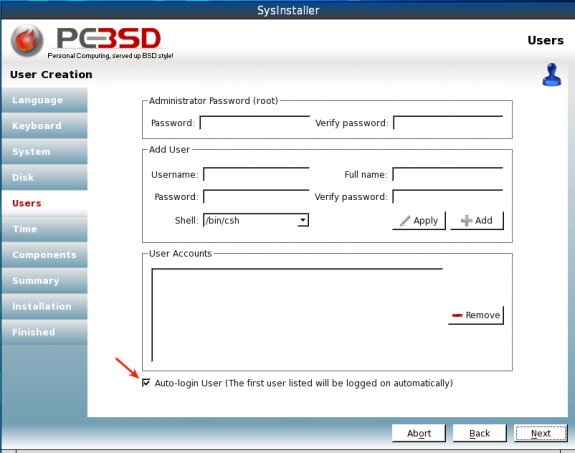
Auto-login is enabled by default
Boot Loader Section: During installation, you have the option, not enabled by default, to install the boot manager. However, unlike on most Linux distributions, there is no boot manager configuration section where you could tweak the boot loader options. It would be better if there is a step during the installation process, preferably just after the Disk section, just for configuring the boot manager.
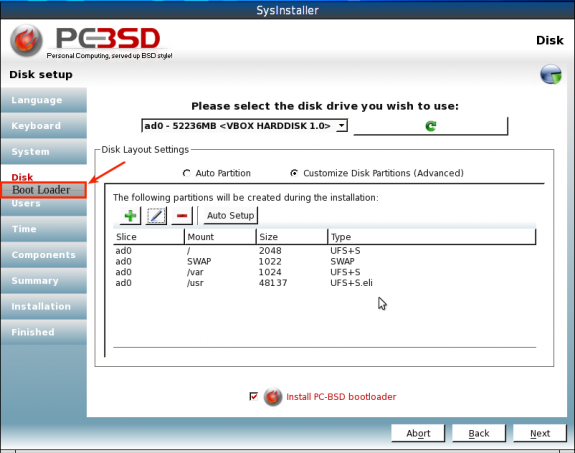
Suggested boot loader configuration section
Disk Encryption: In the previous release of PC-BSD, disk encryption keys (if disk encryption was configured) were auto-generated and stored in /boot/keys. However, with this release, disk encryption keys (passphrases) are user-supplied. That makes the notification message shown below unnecessary. The /boot/keys directory does not even exist.

Disk encryption artifact from PC-BSD 8.0
During installation, the installer lists several packages for you to choose to install. These are, in essence, optional applications. However, looking at the software in the list, I think some of them, like Firefox, K3B, should be in the base packages installed. If you choose not to install any of these “optional” packages, the only Web browser that will installed is Konqueror. While Konqueror is a very good file browser, it is not so good as a Web browser. For one, it is very slow, probably the slowest browser on the planet, and it does not do so well with JavaScript. That is why I would like to see Firefox installed without user intervention. Ditto for K3B, the native CD/DVD burner for the K Desktop Environment.
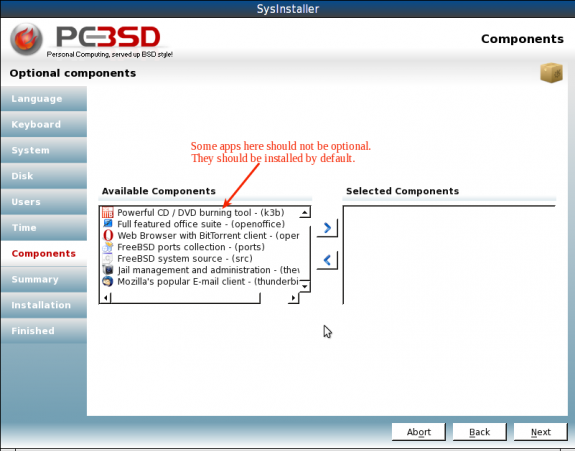
Optional apps that should be installed by default
Time Zone List and NTP Setup: When installing PC-BSD 8.1 (also observed this on PC-BSD 8.0) in a virtual environment (VirtualBox OSE), the dropdown menu list of time zones is empty, which means that you cannot change the default. This issue does not exist when installing on real hardware.
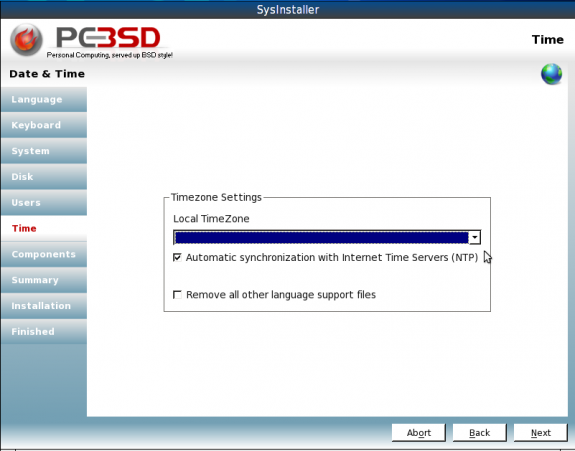
Time zone locales not available in a virtual environment
Network Time Protocol (NTP) is enabled by default in the installer. However, that setting is lost after installation, and attempting to configure NTP fails with the error message shown below. I have also observed this on the KDE versions of a few Linux distributions. So this is not necessarily a PC-BSD-only issue, but more like a KDE bug.
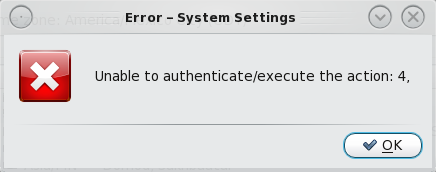
NTP setup fails
Printer Configuration: PC-BSD 8.1 was able to detect my HP F4280 All-in-One printer, but could not auto-configure it. Manual configuration using the HP Device Manager did not succeed. This is the same printer that has been auto-detected and configured by virtually all the Linux distributions reviewed on this site.
Online Update Notifier: All the updates that were applied in the course of testing this release were done through the pbiDIR, and that is because the Online Update Notifier did not work. Any attempt to run it returned the error message shown in the image below.

Online Update Notifier error
Update: The Update Notifier will check for updates on boot, and does work, sometimes (most of the time, actually), but you do get the error message shown in the above image at those times when it fails.

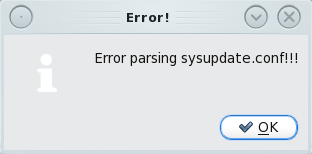
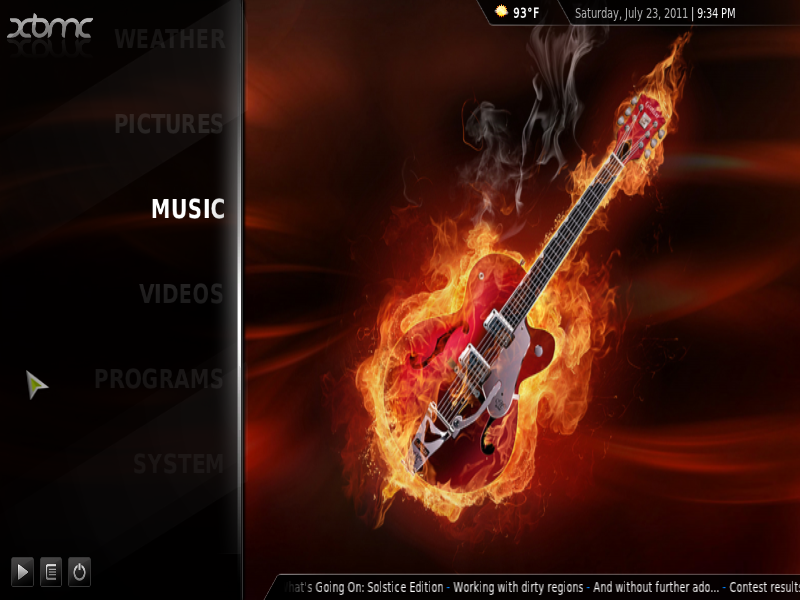

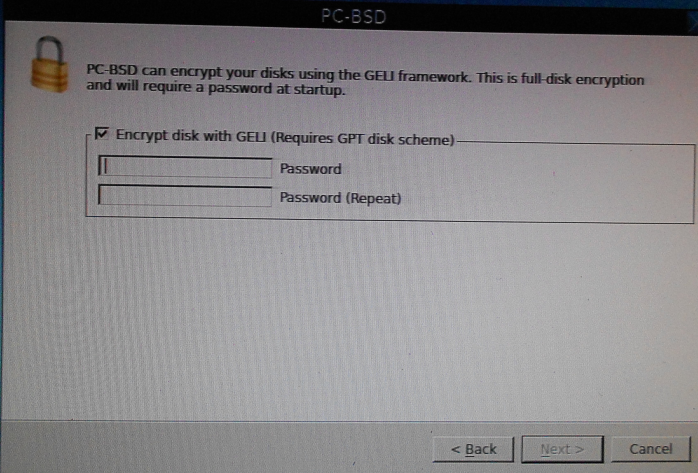



Gotta tell you, KDE has always felt overmuch like Windows to me for me to really be content with it. I keep checking back in, hoping KDE’s evolution eventually moves it further from Win — which is why I’ve been so eagerly awaiting PC-BSD 9. Unfortunately, that seems to be in eternal RC hell.
I AM a lover of XCFE, however: just how easy is it to install over/around/under the KDE WM in PC-BSD?
I see people complaining here about KDE, well haven’t you used Kubuntu, Chakra Linux, PCLinux OS. These are some of the most refined KDE Desktop’s around. The trouble is that BSD is not mature enough to handle anything. I thing not much development is going on in BSD camp.
Quit the crap!!! Install XFCE from the Ports collection and you’ll be on your way. If you want to talk sluggishness, look no further than OpenSUSE.
In my opinion, i don’t like this.
· Change the partition table to GPT and use two primary partition, so freebsd only use a one partition and create two slices.
· Very bug in laptop/netbook (opening opera reboot, opening the konsole and reboot)
· Don’t like wait to update the KDE
· The PBI software is not more updated it and not more software
I’m preferred freebsd. Is easy, lightly, and you configure all, and has not got see this bugs.
It’s fantastic to see this platform getting coverage! I’m a FreeBSD lover, but on my laptop, FreeBSD just couldn’t hack it. It always felt like a proof-of-concept piece, rather than a machine for actually getting work done. I’ve been running PC-BSD on my laptop for about six months now and I agree that it’s probably not yet ready for prime-time; I have to keep a Linux partition, as I still have some wifi and audio issues, as well as the sluggishness Dazza mentioned. But hopefully, if it doesn’t go the way of DesktopBSD, PC-BSD will be the platform that lets me finally get rid of my last Linux partition.
I think PC-BSD is moving in the right direction now with the announcement of the inclusion of alternate desktop environments in ver. 9. KDE is the very reason I couldn’t bare to do a permanent install of PC-BSD. Once Gnome is included, I’ll most likely dedicate a box to it. Or maybe a dual boot with Ghost BSD when it advances enough. Aren’t options great? I’m never going back to Windows. Ever!
win2linconvert
The KDE Plasma Netbook interface makes KDE a lot nicer to use. You should give it a shot. Explore the KDE Plasma Netbook interface
Why the hate? PC-BSD and FreeBSD are excellent. PC-BSD has the right idea for the desktop. Unlike Linux, software installations are self-contained, which means it is much easier to deploy proprietary software than in Linux. It also has a “known” development environment, which makes it much easier to target as a platform – whereas Linux is all over the place. I won’t argue that KDE isn’t the greatest, but that was the choice they made, and they have stuck with it, making the OS consistent and easy to deploy on.
Looks like a bunch of bloat to me. No thanks.
Unfortunately this release is still sluggish, slow as heck and awful in responsiveness. The PC-BSD forums seem to be full of people up their own backsides who don’t like to help with your issues other than to say ‘get a better graphics card’!
Thankfully there are other distros now available with better communities. They also aren’t adamant on sticking with KDE 4 which has proven to be buggy and resource hungry, although using the same version of KDE on a Linux box didn’t throw up the issues KDE on BSD did. Hmm, strange that.
You are right.
PCBSD is very very slow because of kde…
KDE4 is sluggish and gets in your way every time you want to do something useful. Install XFCE and you’ll see just how *not* sluggish things are.